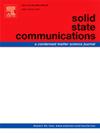Analyzing the link between critical phenomena and magnetocaloric effect in Gd52Fe28B20
IF 2.1
4区 物理与天体物理
Q3 PHYSICS, CONDENSED MATTER
引用次数: 0
Abstract
This study explores critical phenomena (CEs) in amorphous Gd52Fe28B20 near its temperature at which the transition occurs from the ferromagnetic (FM) phase to the paramagnetic (PM) phase. Sample was synthesized using the melt spinning process. Our analysis reveals a second-order (SO) magnetic phase transition from FM state to PM state. We employed various well-established techniques to determine the value of critical exponents, including the modified Arrott plot (MAP), critical isotherm analysis (CIA), Widom scaling relation (WSR), and Kouvel-Fisher (KF). Additionally, separate investigation of the critical behavior was analyzed through the connexion with phenomenon is known as magnetocaloric effect (MCE) yielding results consistent with the analysis of magnetization data. The obtained critical exponent values exhibit consistency and comparability with predictions from the mean field (MF) theory. Finding results emphasis, the presence of long-range FM exchange interactions within the material.
Gd52Fe28B20中临界现象与磁热效应的关系分析
本研究探讨了非晶态Gd52Fe28B20在其温度附近发生从铁磁(FM)相向顺磁(PM)相转变的临界现象(CEs)。采用熔融纺丝法合成了样品。我们的分析揭示了从FM态到PM态的二阶(SO)磁相变。我们采用了各种成熟的技术来确定临界指数的值,包括改进的Arrott图(MAP),临界等温线分析(CIA), Widom缩放关系(WSR)和Kouvel-Fisher (KF)。此外,通过与磁热效应(MCE)现象的联系,分析了临界行为的单独调查,得出的结果与磁化数据的分析一致。所得的临界指数值与平均场理论的预测结果具有一致性和可比性。发现结果强调,材料内存在远程调频交换相互作用。
本文章由计算机程序翻译,如有差异,请以英文原文为准。
求助全文
约1分钟内获得全文
求助全文
来源期刊

Solid State Communications
物理-物理:凝聚态物理
CiteScore
3.40
自引率
4.80%
发文量
287
审稿时长
51 days
期刊介绍:
Solid State Communications is an international medium for the publication of short communications and original research articles on significant developments in condensed matter science, giving scientists immediate access to important, recently completed work. The journal publishes original experimental and theoretical research on the physical and chemical properties of solids and other condensed systems and also on their preparation. The submission of manuscripts reporting research on the basic physics of materials science and devices, as well as of state-of-the-art microstructures and nanostructures, is encouraged.
A coherent quantitative treatment emphasizing new physics is expected rather than a simple accumulation of experimental data. Consistent with these aims, the short communications should be kept concise and short, usually not longer than six printed pages. The number of figures and tables should also be kept to a minimum. Solid State Communications now also welcomes original research articles without length restrictions.
The Fast-Track section of Solid State Communications is the venue for very rapid publication of short communications on significant developments in condensed matter science. The goal is to offer the broad condensed matter community quick and immediate access to publish recently completed papers in research areas that are rapidly evolving and in which there are developments with great potential impact.
 求助内容:
求助内容: 应助结果提醒方式:
应助结果提醒方式:


